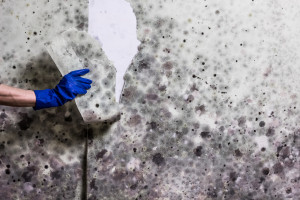This entry was posted on Monday, October 16th, 2017 and is filed under Blog by AENT Associates
At Allergy & ENT Associates we advocate avoidance of the “Three Ds” of mold: darkness, dampness and drafts. Unfortunately the recent flooding and damage inflicted by Hurricane Harvey have created a perfect storm where the three Ds are running rampant through many residences in the Houston area.
If your house, apartment, condo or other type of domicile was affected it’s more important now than ever to be aware of the three Ds and do your best to mitigate them before mold spores take hold or mold issues become worse. Hurricanes deliver a “perfect storm” of mold-friendly conditions, soaking everything, including places between walls, crawlspaces and other dark, drafty places in a building. The timing doesn’t help either, as late summer and early fall tend to be peak mold season.
“Mold spores can deposit in the lungs and nasal cavity, triggering illnesses such as asthma, allergic rhinitis and sinusitis,” warns board-certified Allergy & ENT Associates allergist Dr. Vikas Kancherla.
If members of your household suffer from allergies, asthma or other respiratory issues, it’s vitally important they avoid exposure to mold. People with these issues are more sensitive to mold and should avoid it at all costs.
This rule is also true for people who have immune-suppressing diseases or issues such as those with HIV, people currently undergoing cancer treatments such as chemotherapy and those who have had organ transplants.
Ways to Counteract, Prevent and Remediate Mold Affecting Your Home
There are a variety of steps you could and should take to minimize the risk for or effects of mold. Here are just a few.
Protect Yourself with Breathing Masks
Even if your family’s home suffered significant flood and water damage, you’ll eventually need to go back to begin recovery and salvage what you can. Before entering a building with a high potential for or confirmed mold growth, it’s highly advisable to protect yourself with a breathing mask or respirator. At a minimum the mask should be rated as N95. The Center for Disease Control and Prevention sets mask standards, and N95 essential means masks with this rating will block 95 percent of particles larger than 0.3 microns in size. Mold spores, for example, generally range between 10 to 30 microns in size.1
Dry Out Is Essential
The best way to avoid or minimize the growth of mold after any type of flooding is eliminating the conditions in which mold thrives – the three Ds. Employing the assistance of a professional damage mitigation company is the most reliable way to get results that will keep your family safe. Their specialized drying and dehumidifying machines allow for rapid elimination of moisture and humidity, which is probably the most important aspect of preventing mold. Getting into hard to reach places can be more difficult. After flooding damage like Harvey all carpet and carpet mats, drywall and furniture affected by flooding will likely need to be removed and replaced.
In terms of your possessions, the more porous something is the more likely it is to be affected by mold. Anything that soaks up water will likely need to go. If you are going to try to keep something, clean it with a bleach-based detergent and water.
Important Insurance Warning!
If your homeowners insurance covers flood damage it may be in your best interest to move damaged possessions out on to the lawn instead of throwing them away. This will assist with documenting damage and your possessions to improve your chances for maximum recovery on your claim.
Don’t leave these things in the house though, as having furniture or other possessions in your home that are molding will counteract or reverse any remediation work currently being performed in the house. Once an area is cleaned of mold and spores it’s important to ensure it does not become re-contaminated.
Dealing with Mold Allergies
We suggest keeping humidity between 30 and 50% through the use if dehumidifiers, in addition to prescription medication and treatments. Unfortunately these measures aren’t always adequate for people who have severe mold allergies or are in a situation where it’s hard to avoid mold spores, such as now after a severe flooding event. In these cases we often recommend more aggressive immunotherapy to reduce your sensitivity to mold.
If you or a loved one want to get tested for mold allergy or you’re looking for advice or treatment solutions, please contact our allergy and asthma specialists at Allergy & ENT Associates by calling (713) MY-SINUS.
1http://www.engineeringtoolbox.com/particle-sizes-d_934.html


